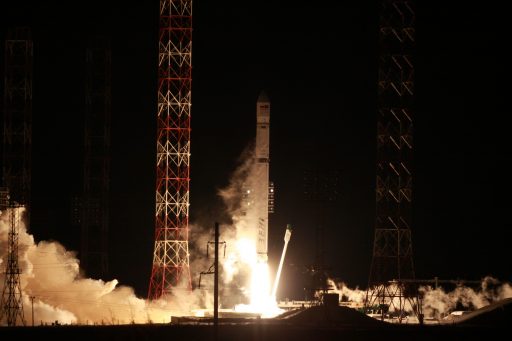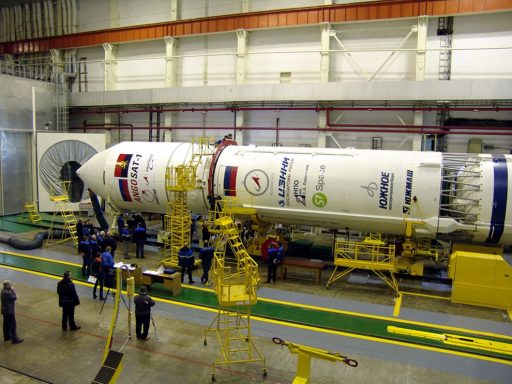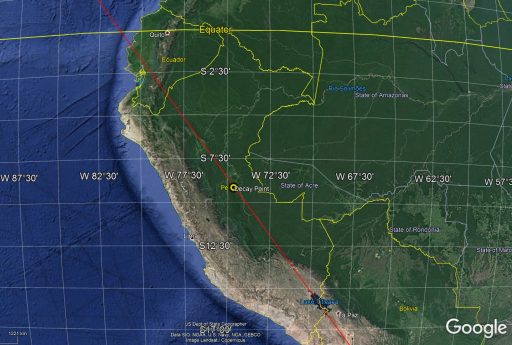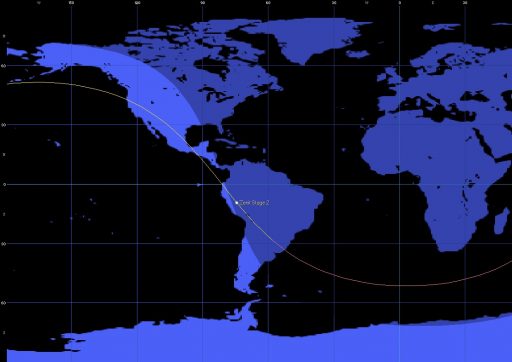Zenit Rocket Parts Crash Land in Peru

The re-entry of an eight-metric-ton Zenit rocket stage was observed from the Peru/Brazil border in the afternoon skies of January 27, 2018, one month after the rocket took off from the Baikonur Cosmodrome to lift a communications satellite into orbit for Angola. Peruvian villagers discovered debris related to the incident in the days after the rocket stage fell.
The Zenit rocket, carrying the 1,647-Kilogram AngoSat-1, lifted off from the Baikonur Cosmodrome on December 27, 2017 on a multi-hour ascent mission directly into a drift orbit near the Geostationary Belt where the world’s high-altitude telecommunications satellites reside. The first stage of the rocket, propelled by the world’s most powerful liquid-fueled rocket engine, fired for two minutes and 25 seconds and impacted downrange from the launch site – handing off to the second stage of the rocket that was in charge of powered flight for a little over six minutes.

The spent second stage reached an initial orbit of 166 by 547 Kilometers inclined 51.4° and the Fregat Upper Stage continued a mission of close to nine hours featuring three main engine firings to drop the satellite off in a Geostationary Drift Orbit, slightly higher in altitude than satellites in the Geostationary Belt.
With a perigee below 200 Kilometers, the second stage was set for a gradual descent towards the dense atmosphere due to interaction of the spent rocket body with the tenuous upper layers of Earth’s atmosphere where it was slowed down by drag. As a result, the apogee of the rocket stage’s orbit gradually dropped and the orbit got more circular as is always the case when objects decay from an eccentric orbit. The exact speed of orbital decay depends on atmospheric conditions that are influenced by solar activity and therefore make it difficult to accurately predict the time an objects re-enters. Because spent rocket bodies have a low mass and relatively large surface area, their descent towards the dense layers of the atmosphere is relatively fast.

The second stage of the AngoSat-1 launch re-entered the atmosphere at 23:32 UTC on January 27 +/-1 Minute, placing the position of orbital decay over Central Peru, some 400 Kilometers north-east of the country’s capital Lima. Observers reported seeing a bright object passing across the twilit sky with a speed distinctly slower than any natural meteors. Amateur footage shows a bright object with a visible smoke trail in the twilight skies before breaking up into a number of fragments and heading for the horizon.
Zenit’s second stage is 10.4 meters long and 3.9 meters in diameter with an inert mass of 8,307 Kilograms, capable of holding 90,800 kg of propellants consumed by an RD-120 main engine and RD-8 vernier to lift payloads up to 13,500 Kilograms into orbit.
First, the Zenit rocket stage only appeared as a small bright dot moving across the sky as plasma began building up around it. Given the extremely high speed of the object at Entry Interface (7.8km/s), air in front of it is compressed, creating a shock wave layer in which molecules are separated into ions and temperatures rise to the extreme.

The shock wave layer forming just in front of the spacecraft and any separated components leads to considerable heating that causes the incineration of the majority of the spacecraft structure.
The mechanical deceleration experienced during re-entry can be up to 20Gs – further crushing the structural components and causing the break-up of the spacecraft. Although temperatures reached during re-entry can melt most metals, dense components and those that are shielded by other parts can survive the re-entry environment and typically impact 800 to 1,300 Kilometers downrange from the Orbital Decay Point depending on their properties and atmospheric conditions such as crosswinds.
Villagers discovered spherical objects in the days after the re-entry. Small spherical tanks, typically used to hold reaction control system propellant or tank pressurant gases, are often found as surviving objects after rocket body re-entries along with heavier engine components. A previous re-entry of a Zenit over Thailand also strewed a series of RCS tanks over the countryside.

NORAD ID: 43090
Object: SL-23 R/B
Origin: Russia
Type: Zenit 3SLBF Second Stage
Mass: 8,307 Kilograms
Launch: December 27, 2017 – 19:00 UTC
Launch Site: 45/1 Baikonur Cosmodrome
Launch Vehicle: Zenit-3SLBF
Ascent Duration: 8 Hours & 54 Minutes
Payload: AngoSat-1 (1,647kg)
Re-Entry Prediction: January 27, 2016 – 23:32 UTC +/-1 Minute
Re-Entry Location: Peru

